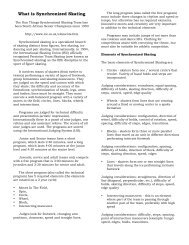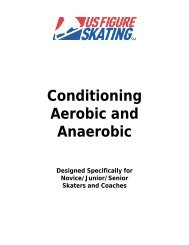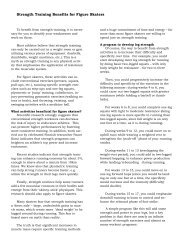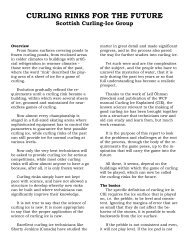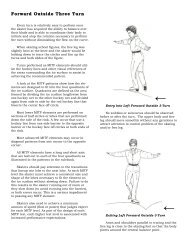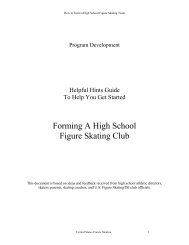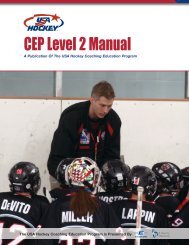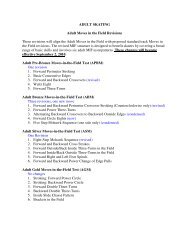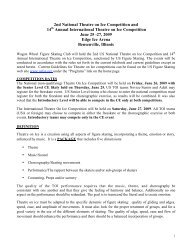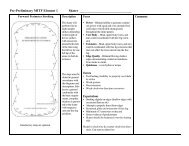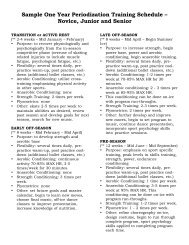Core Body Training - Ice skating resources
Core Body Training - Ice skating resources
Core Body Training - Ice skating resources
You also want an ePaper? Increase the reach of your titles
YUMPU automatically turns print PDFs into web optimized ePapers that Google loves.
o pectineus<br />
o sartorius<br />
• Gluteus medius and minimus - located<br />
at the side of the hip<br />
• Gluteus maximus, hamstring group,<br />
piriformis - located in the back of the<br />
hip and upper thigh leg.<br />
• Hip adductors - located at medial<br />
thigh.<br />
Strengthening the <strong>Core</strong> Reduces Back<br />
Pain<br />
Abdominals get all the credit for<br />
protecting the back and being the<br />
foundation of strength, but they are only a<br />
small part of what makes up the core. In<br />
fact, it is weak and unbalanced core<br />
muscles that are linked to low back pain.<br />
Weak core muscles result in a loss of<br />
the appropriate lumbar curve and a<br />
swayback posture. Stronger, balanced<br />
core muscles help maintain appropriate<br />
posture and reduce strain on the spine.<br />
<strong>Core</strong> Strength <strong>Training</strong> and Athletic<br />
Performance<br />
Because the muscles of the trunk and<br />
torso stabilize the spine from the pelvis to<br />
the neck and shoulder, they allow the<br />
transfer of powerful movements of the<br />
arms and legs.<br />
All powerful movements originate from<br />
the center of the body out, and never from<br />
the limbs alone. Before any powerful,<br />
rapid muscle contractions can occur in<br />
the limbs, the spine must be solid and<br />
stable and the more stable the core, the<br />
most powerful the extremities can<br />
contract.<br />
<strong>Training</strong> the muscles of the core also<br />
corrects postural imbalances that can lead<br />
to injuries. The biggest benefit of core<br />
training is to develop functional fitness -<br />
that is, fitness that is essential to both<br />
daily living and regular activities.<br />
<strong>Core</strong> strengthening exercises are most<br />
effective when the torso works as a solid<br />
unit and both front and back muscles<br />
contract at the same time, multi joint<br />
movements are performed and<br />
stabilization of the spine is monitored.<br />
Strengthening the <strong>Core</strong> Muscles<br />
There are many exercises that will<br />
strengthen the core, as well as exercise<br />
equipment that will aid this training.<br />
Some of the best products for developing<br />
core strength include:<br />
• Medicine Balls<br />
• Kettlebells<br />
• Stability Balls<br />
• Balance Products – i.e. Bosu Ball,<br />
balance boards, wobble boards, etc.<br />
• Dumbbells<br />
No Equipment <strong>Core</strong> Strength Exercises<br />
<strong>Body</strong> weight exercises are very effective<br />
for developing core strength. They are also<br />
the type of exercises many athletes and<br />
coaches rely on for regular core training.<br />
They include:<br />
Abdominal Bracing<br />
This is the main technique used during<br />
core exercise training. It refers to the<br />
contraction of the of the abdominal<br />
muscles.<br />
To correctly brace, you should attempt<br />
to pull your navel back in toward your<br />
spine. This action primarily recruits<br />
transverse abdominus.<br />
You should be able to breathe evenly<br />
while bracing. Be careful not to hold your<br />
breath while performing the following<br />
exercises:<br />
• Plank Exercise: Start Position | Finish<br />
Position<br />
• Side Plank Exercise: Start Position |<br />
Finish Position<br />
• The Basic Push Up<br />
• V-sits<br />
• Push Ups<br />
• Squats



